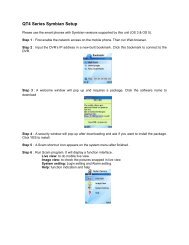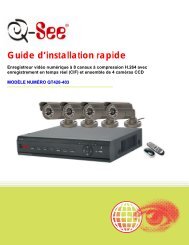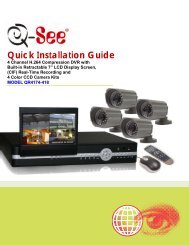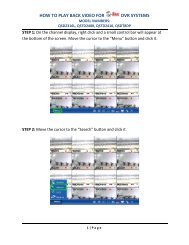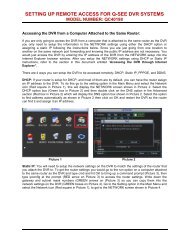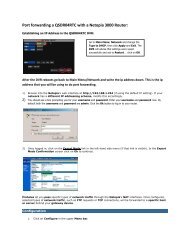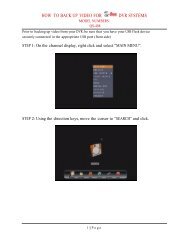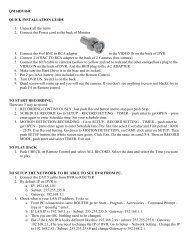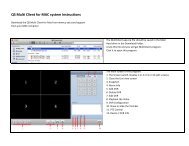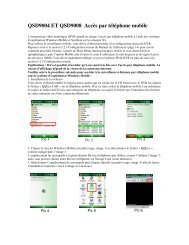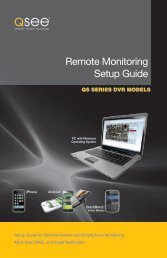User Manual - Q-See
User Manual - Q-See
User Manual - Q-See
Create successful ePaper yourself
Turn your PDF publications into a flip-book with our unique Google optimized e-Paper software.
Schedules can be set individually for each day. The cameras are default configured to<br />
be recording in both Motion Detection and Schedule recording 24/7 and will have fulllength<br />
colored bars in the schedule window. Above each window is a 0-24 with segments<br />
corresponding to each hour of the day. This will show when a camera has been scheduled to<br />
record in that mode.<br />
NOTE! When setting up your recording schedule for the first time, it is faster<br />
and easier to begin by selecting the mode’s schedule window and selecting<br />
Delete All to clear the schedule before making changes.<br />
To create a new schedule;<br />
STEP 1. Select the camera name in one<br />
of the three record mode groups.<br />
STEP 2. Click on Add.<br />
6.3 RECORDING TO HARD DRIVE<br />
<strong>User</strong>s can determine where recorded files will be saved on their hard drive(s). In addition,<br />
the recorder can save to a series of drives or partitions by automatically jumping to the next<br />
partition when the current one is full. If all the partitions are full and Recycling Record mode<br />
has been enabled prior to recording by checking the box below the Storage Disk list, the new<br />
data will overwrite the oldest recorded data automatically.<br />
The destination drive(s) for recordings -<br />
which also applies to images captured using<br />
the Snapshot button - is set in the Basic<br />
Configuration window. You can also set<br />
a HDD minimum storage alarm which will<br />
cause the system to alert you once the that<br />
threshold has been reached. If the present<br />
storage space is less than the minimum<br />
storage needed and Recycling Recordings is<br />
not selected, the recording will automatically<br />
stop.<br />
STEP 3. This will open a new window.<br />
Set the start time and end time along<br />
with the day(s) to which you wish the<br />
schedule to apply.<br />
STEP 4. Click OK to exit the Add<br />
window.<br />
PICTURE 6-6<br />
PICTURE 6-7<br />
Your new schedule will appear as a series of colored bars corresponding to the day(s) and<br />
time(s) you’ve selected.<br />
To edit a schedule, select a block of time and click Edit. You will be able to adjust the<br />
schedule for that day and any other day in the same manner you used to create the schedule<br />
in the Add window.<br />
PICTURE 6-8<br />
WARNING! You should have your files record to a disk or partition OTHER<br />
than your “C” drive. This will avoid issues with the Recycling function.<br />
CHAPTER 6 RECORDING, PLAYBACK AND RECORD SEARCH<br />
NOTE! When adding a new schedule, it should not duplicate an existing<br />
schedule as this may cause a system error.<br />
To add another block of time, such as an evening recording schedule to go with an early<br />
morning schedule, you will need to repeat the process.<br />
Clicking on Delete will remove a specific block of time from a specific day’s schedule.<br />
Copy To allows you to apply the settings for one camera to another camera as well.<br />
26 27




